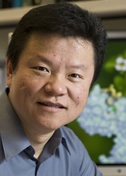Towards Personalized Oncology
Mark Lemmon
University of Pennsylvania (now at Yale School of Medicine)
Published July 16, 2013
Mark Lemmon's career in structural biology began with a decision not to pursue structural biology. At Oxford University as an undergraduate, he'd been drawn to understanding biochemistry at a structural level. But the thing he wanted to understand most, transmembrane signaling, posed a problem. "In the late 1980s, solving crystal structures of membrane proteins wasn't something one could expect to do," says Lemmon, George W. Raiziss Professor of Biochemistry and Biophysics at the University of Pennsylvania.
So he decided to study membrane signaling using molecular instead of structural techniques. His graduate work at Yale University involved making lots of mutations in the transmembrane region of the epidermal growth factor receptor (EGFR) and collecting data on which mutations affected dimerization.
At that time researchers had only just begun to understand the 58 tyrosine kinases in the human proteome, of which EGFR is one. "In the beginning, everyone assumed they all worked the same way," says Lemmon. "But later we realized that they all have their foibles."
After completing his PhD, Lemmon did a post-doc in a pharmacology lab at New York University, where he shifted his focus from the part of the protein that sits within the membrane, just 2% of the whole EGF receptor, to the intra- and extracellular domains.
He also shifted his methods. "I basically joined a non-crystallographer's lab and started getting more interested in crystallography," says Lemmon.
Lemmon's goal was to understand cellular signaling and molecular regulation, but he wanted to understand this at the structural level. While at NYU he collaborated with the late Paul Sigler, a prominent structural biologist at Yale, and Kate Ferguson, then a student in Sigler's lab, and now Lemmon's wife.
In parallel, as basic curiosity drove Lemmon and others to understand the mechanisms of these important signaling molecules, clinical researchers had begun to recognize that kinases with mutations often become oncoproteins.
Today Lemmon's lab focuses on the clinical relevance of these kinases. "Now more than ever we need to understand the details of how these receptors work so that when a mutation appears in the clinic, we can know what it means from our knowledge of mechanism and structure," he says.
Lemmon is collaborating with oncologists at Penn who have sequenced the ALK gene in nearly 2000 neuroblastoma tumors and found 50 different mutations. About 30% of those mutations are not active cancer-drivers, so ALK-inhibiting drugs will likely have no effect.
The problem is, no one knows which mutations are active and which are silent. So Lemmon is looking at each mutation structurally, biochemically and even pharmacologically to understand which mutations matter. "We're bringing structural biology in to personalized medicine," he says.
Lemmon is also about to launch a similar project focusing on EGFR. "I'm going back full circle to where I started," he says, trying to solve the structure of this large transmembrane protein and understand how the full-length receptor really works. The challenges are still "enormous," he says, so he is employing multiple methods in addition to crystallography, including mass spectrometry and electron microscopy.
Lemmon, as chair of his department, wants to lower the bar for researchers to use all the methods they need, so he and six other labs at Penn have signed on to SBGrid. "Suddenly labs that have an inkling that they want to do crystallography, who've been scared of it before, now have everything in place," says Lemmon. "Their biggest challenge is getting the data rather than analyzing it."
-- Elizabeth Dougherty





































































































































